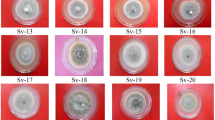Summary
This paper is a brief review of the work done on 10 valid species ofSclerospora occurring in India and important contributions made to this genus in respect of 1. mode of infection and recurrence of disease, 2. conidial production, 3. proliferation of conidiophores, 4. physiologic specialization, 5. host range and 6. oospore germination.
Similar content being viewed by others
Abbreviations
- A:
-
Conidiophore and conidia)
- A1 :
-
foot cell of conidiophore)
- A2 :
-
proliferated spikelets
- B:
-
Conidia
- C:
-
Zoospores & germination)
- C1,2 & 3 :
-
Conidial germination
- D:
-
Oospore
- DA :
-
Germination of oospore)
- D1-D5 :
-
Stages in oospore formation
References
Arya, H. C. &R. Sharma. 1962. On the perpetuation and recurrence of the “green ear” disease of Bajra (Pennisetum typhoides) caused byScl. graminicola (Sacc.)Schroet. Indian Phytopath.15 (2): 166–172.
Ayyangar, G. N. R. &P. V. Hariharan. 1935.Sclerospora species and suppression of the awn in Sorghum. Curr. Sci.3: 363.
Butler, E. J. 1907. Some diseases of cereals caused byS. graminicola. Mem. Dept Agri. India. Bot. Ser.II: 1–21.
Butler, E. J. 1913. The downy mildew of Maize. Ibid.5: 275–280.
Butler, E. J. 1918. Fungi and diseases in Plants, Thacker Spink & Co., Calcutta.
Butler, E. J. &G. R. Bisby. 1931. Fungi of India, Calcutta, Govt. of India Central Publication Branch.
Chaudhuri, H. 1932.S. graminicola on Bajra (P. typhoideum). Phytopath.22: 241–46.
Chona, B. L. &D. Suryanarayana. 1955. The Occurrence ofS. philippinensis West. on “Kans Grass” (Saccharum spontaneum L.) in India. Indian Phytopath.,8 (2): 209–211.
Hiura, M. 1930. A simple method for germination of oospores ofS. graminicola. Sci. N.S.,72: 95.
Ito, S. 1913. Kleine Notizen über parasitische Pilze Japans. Bot. Mag. Tokyo27: 217–223.
Kulkarni, G. S. 1913. Observations on Downy mildew.S. graminicola on Bajra and Jowar. Mem. Dept. Agri. India. Bog Ser.5: 268–274.
Mitter, J. H. &R. N. Tandon. 1930. A note onS. graminicola (Sacc.)Schroet. in Allahabad, J. Ind. bot. Soc.9: 243.
Miyake, T. 1911. On the fungus disease of Sugar cane caused by a new parasitic fungus.S. Sacchari. Dept. Sugar Expt. Stat. Govt. Formosa, Div. Path. Bull.1: 61 (in Japanese).
Palm, B. 1918. Onderzoekingen over de Omo Lijer van de mais (with an english summary). Meded. Laboratorium Planten Ziekten (Batavia)32: 78.
Patel, M. K. 1949. Production ofS. Sorghi on Maize. Indian Phytopath.2 (2): 46.
Patel, M. K., M. N. Kamat, N. B. Kulkarni &M. K. Desai. 1950. Occurence of “Green-ear” stage in Sorghum. Curr. Sci.19: 156.
Raciborski, M. 1897. Lijer, eine gefährliche Maiskrankheit. Ber. bot. Ges.15 (8): 475–478.
Saccardo, P. A. 1888. Syll. Fung.7: 238.
Safeeulla, K. M. &M. J. Thirumalachar. 1955. Resistance toS. Sorghi infection in some sorghum & maize varieties in Mysore. Phytopath.45: 128–131.
Safeeulla, K. M. &M. J. Thirumalachar. 1955. Gametogenesis & Oospore formation inSclerospora sp. onSorghum vulgare, Mycol.47: 177–85.
Safeeulla, K. M. &M. J. Thirumalachar. 1956. Periodicity factor in the production of asexual phase inS. graminicola &S. sorghi and the effect of moisture and temperature on the morphology of sporangiophores. Phytopath. Z.26: 41–48.
Srinivasan, M. C., M. J. Narasimhan &M. J. Thirumalachar. 1961. A newSclerospora onIseilema laxum. Bull. Torrey Bot. Club,88 (2): 91–94.
Subramanian, L. S. 1931. A note on the downy mildew of Sugarcane in India. Agri. Live Stock IndiaI: 32–33.
Suryanarayana, D. 1952. Infection caused by the Oospores ofS. graminicola (Sacc.)Schroet. onP. typhoides Stapf. &Hubb. Indian Phytopath5 (2): 56–75.
Suryanarayana, D. 1954. Infection caused by Oospores ofS. sorghi (Kulk)West &Uppal onSorghum vulgare. Pers. Indian Phytopath7: 73.
Suryanarayana, D. 1956. Oospore germination ofS. graminicola on Bajra (P. typhoides Stapf. &Hubb.) Indian Phytopath.9 (2): 182–183.
Suryanarayana, D. 1962. Occurrence of an unknown fungal mycelium inside the sound grains produced on partly formed green ears of Bajra plants. Sci & Cult.28 (11): 536.
Thirumalachar, M. J. &M. J. Narashimhan. 1949. Downy mildew onEleusine coracana andIseilema laxum in Mysore. Indian Phytopath.2: 46–51.
Thirumalachar, M. J. &M. J. Narasimhan. 1952. A newSclerospora onDicanthium annulatum, Phytopath.,42: 596–598.
Thirumalachar, M. J. &Whitehead. 1952. Sporangial phase ofScl. Butleri, Amer. J. Bot.39: 416–418.
Thirumalachar, M. J., C. G. Shaw &M. J. Narasinham. 1953. The sporangial phase of downy mildew onE. coracana, with a discussion on the identity ofS. macrospora Sacc. Bull. Torrey Bot. Club,80: 299–307.
Uppal, B. N. &M. N. Kamat. 1928. Artificial infection ofPennisetum typhoideum byS. graminicola. Agric. J. India.23: 309–310.
Uppal, B. N. 1928–1929. Appendix M, Summary of work done under plant Pathologist to Govt. of Bombay Presidency, Poona, for the year 1928–1929, 199–204.
Uppal, B. N. 1930.Ibid., for the year 1930, : 236.
Uppal, B. N. &M. K. Desai. 1931. Physiologic specialisation inS. graminicola, Phytopath.,21: 337–38.
Uppal, B. N. &M. K. Desai. 1931. Physiologic specialisation inS. graminicola (Sacc).Schroet. Ind. J. Agric. Sci.2: 667–678.
Uppal, B. N. &M. K. Desai. 1932. Two new hosts of Downy mildew of Sorghum in Bombay. Phytopath.,22: 587–594.
Uppal, B. N. &W. H. Weston, 1936. The basis for mergingS. indica withS. philippinensis. Ind. J. agric. Res.6: 715–719.
Weston, W. H. 1920. The Philippine downy mildew of Maize. J. agric. Res.19: 97–122.
Weston, W. H. 1924. Noctural production of conidia byS. graminicola Ibid.,27: 771–784.
Weston, W. H. 1929. A newSclerospora from Australia. Phytopath.,19: 1107–1115.
Weston, W. H. 1933. A newSclerospora from NyasalandIbid. 23: 578–595.
Weston, W. H. 1942. The conidial phase ofSclerospora noblei.Ibid. 32: 206–213.
Weston, W. H. &B. N. Uppal. 1932. The basis forS. sorghi as a species.Ibid. 22: 578–586.
Author information
Authors and Affiliations
Additional information
Research Scholar of University Grants Commission.
Rights and permissions
About this article
Cite this article
Anantha Narayanan, S. The genus sclerospora in India. Mycopathologia et Mycologia Applicata 20, 315–327 (1963). https://doi.org/10.1007/BF02089219
Issue Date:
DOI: https://doi.org/10.1007/BF02089219




